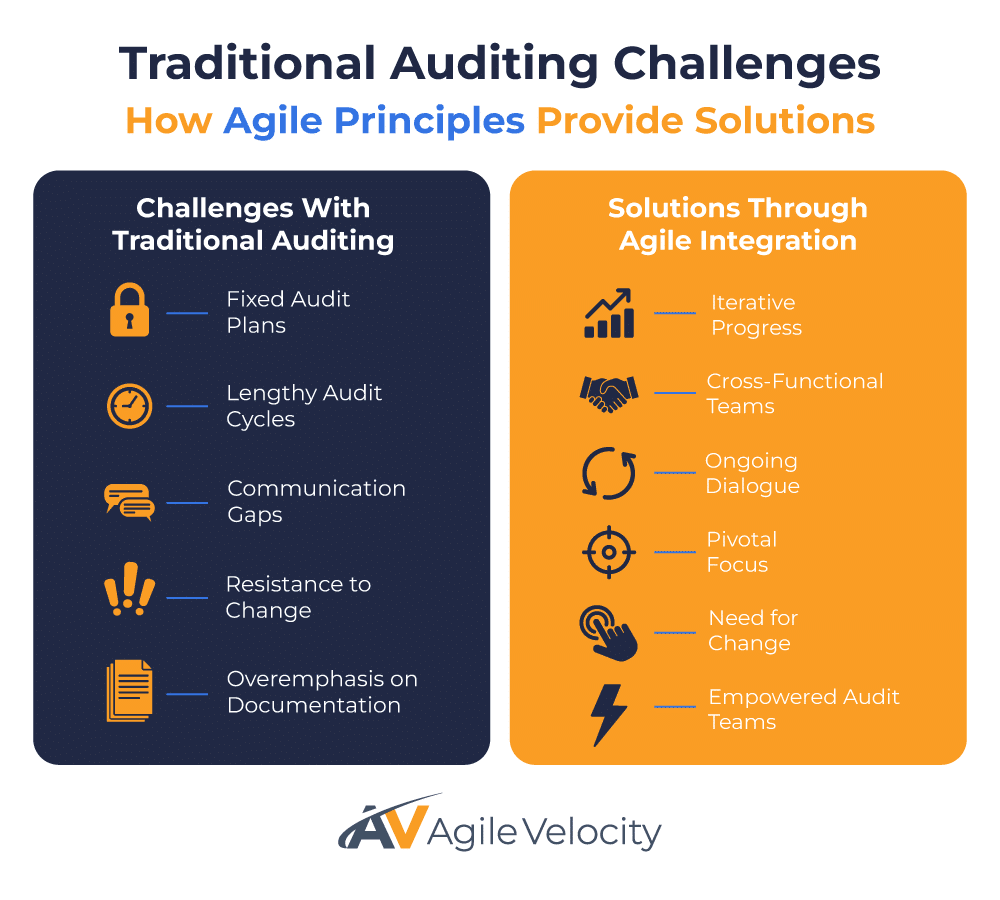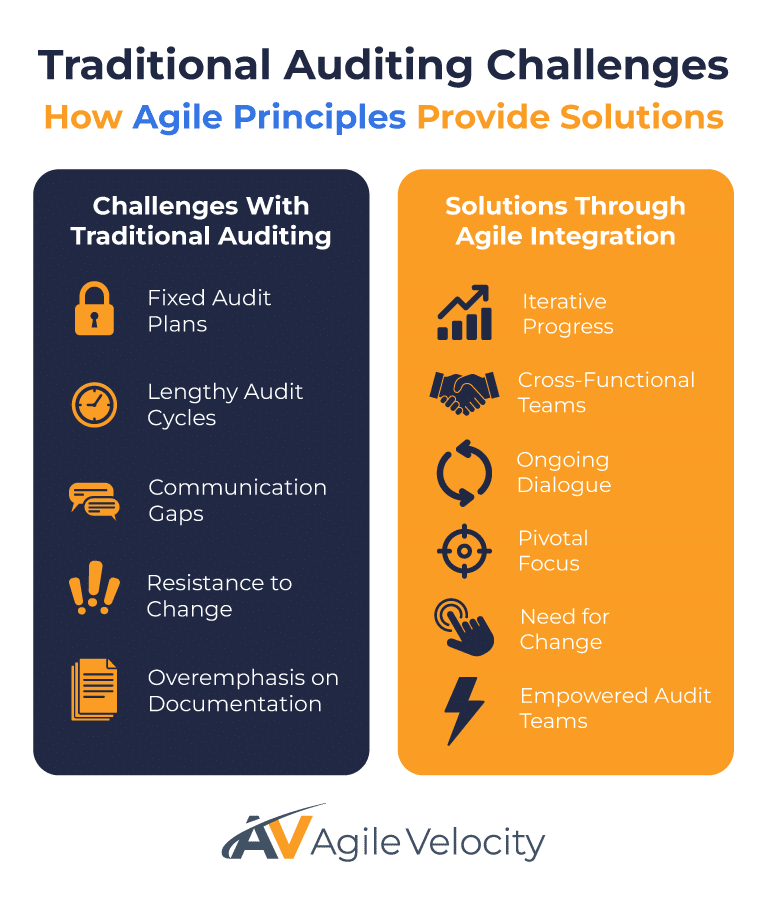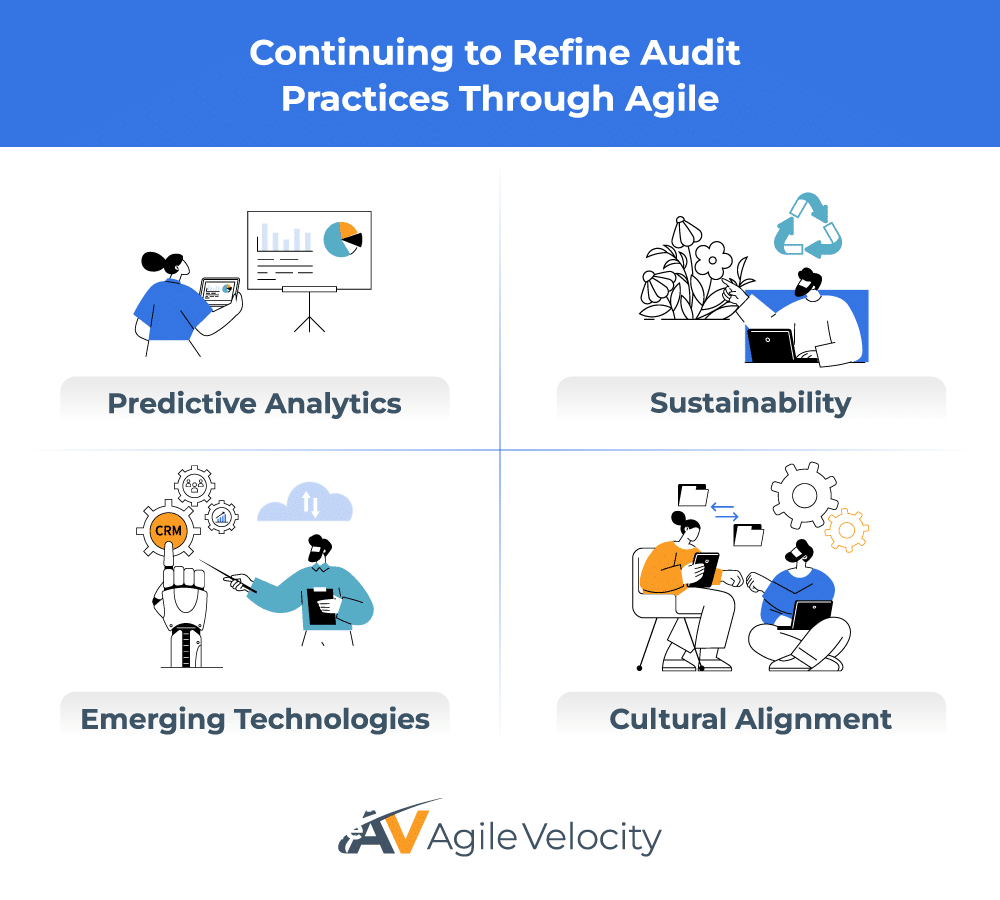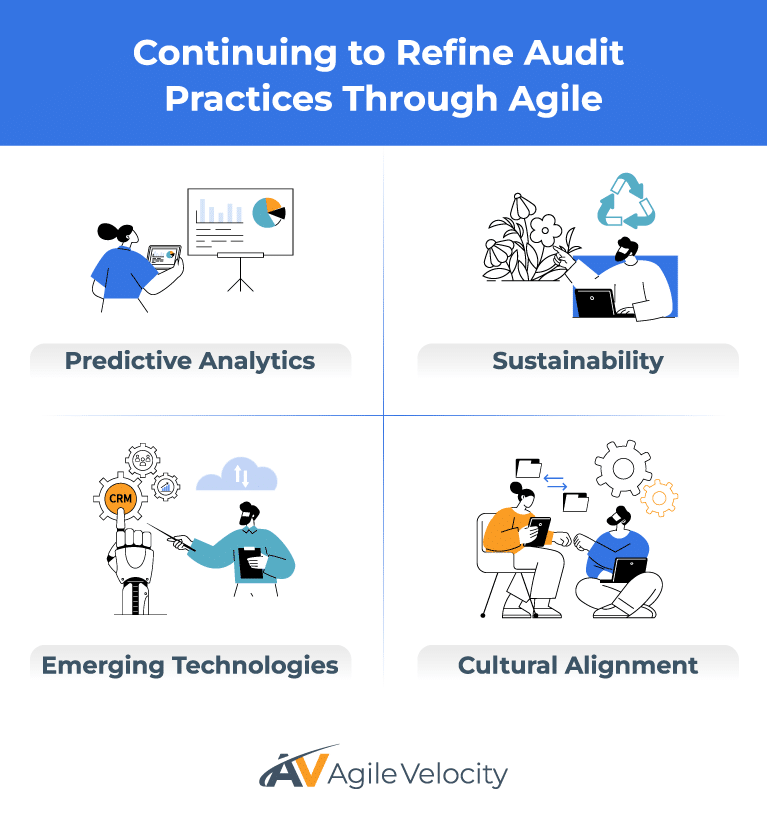In today’s dynamic business landscape, organizations grapple with increasing complexity and swift changes. Traditional auditing methods often struggle to keep pace, leading to inefficiencies and delayed insights. Enter Agile Auditing—a groundbreaking approach that integrates Agile principles into internal audit practices. By embracing flexibility, collaboration, and iterative progress, Agile Auditing revolutionizes internal audits, enhancing efficiency and delivering greater value to stakeholders.
Agile Auditing not only streamlines the audit process but also aligns audit activities more closely with organizational goals. This alignment ensures that audits are strategic tools contributing to the organization’s agility and responsiveness. As businesses navigate evolving markets and regulatory landscapes, adopting Agile Auditing becomes essential for maintaining competitiveness and achieving sustainable growth.
Challenges in Traditional Auditing Practices
Conventional auditing practices are characterized by rigid procedures and lengthy review cycles, presenting several challenges:
- Limited Responsiveness: Fixed audit plans make it difficult to adapt to emerging risks or organizational changes, resulting in outdated findings.
- Inefficient Processes: Lengthy audit cycles consume significant resources and can lead to auditor burnout.
- Stakeholder Engagement Gaps: Infrequent communication may cause misalignment between audit objectives and business needs.
- Difficulty Adapting to Change: The static nature of traditional audits hinders the ability to address evolving regulatory requirements and technological advancements.
- Overemphasis on Documentation: Traditional audits often prioritize comprehensive documentation over actionable insights, delaying the implementation of necessary improvements.
These challenges highlight the need for a more dynamic and responsive approach to internal auditing. Traditional methods, while thorough, can become bottlenecks in a rapidly changing environment, making it imperative for organizations to seek more agile and efficient audit solutions.
Integrating Agile Principles into Auditing
Agile Auditing brings the core Agile principles into the internal audit function. Key Agile principles applicable to auditing include:
- Iterative Progress: Breaking down audits into manageable sprints allows for incremental progress and timely adjustments based on findings.
- Collaborative Teams: Cross-functional teams enhance the depth of audits by bringing diverse expertise together.
- Continuous Feedback: Regular events and reviews facilitate ongoing dialogue with stakeholders, ensuring alignment and immediate issue resolution.
- Flexibility and Adaptability: Auditors can pivot focus areas in response to real-time data and emerging risks, maintaining relevance and impact.
- Empowered Audit Teams: Enable teams by decentralizing decision-making, allowing auditors to quickly address issues and innovate within the audit process, promoting ownership and proactive problem-solving.
Implementing these principles requires a cultural shift, fostering openness to change, collaboration, and continuous improvement within audit teams.


Benefits of Agile Auditing
Adopting Agile Auditing practices offers numerous benefits:
Increased Responsiveness
Agile allows audit teams to swiftly adapt to organizational changes and emerging risks. By working in short sprints, auditors can quickly adjust their focus based on new information, ensuring that audit activities remain relevant and timely. This increased responsiveness means that audits can address the most pressing issues as they arise, rather than being constrained by long planning cycles.
Enhanced Stakeholder Engagement
Continuous collaboration and transparency are fundamental to Agile Auditing. Regular events and feedback sessions involve stakeholders throughout the audit process, improving alignment with business objectives and building confidence in audit findings. Engaged stakeholders are more likely to support audit initiatives and implement recommendations, leading to more effective risk management and organizational improvement.
Continuous Audit Quality Improvement
Agile practices foster a culture of continuous improvement. Through regular reflections, audit teams assess processes and outcomes, identifying areas for enhancement. This iterative approach leads to higher audit quality and more meaningful insights. By continually refining their methods and approaches, audit teams can stay ahead of potential issues and consistently deliver value to the organization.
Efficient Use of Resources
By streamlining processes and reducing audit cycle times, Agile Auditing optimizes resource utilization. Auditors spend less time on administrative tasks and more on strategic analysis, increasing overall productivity. This efficient use of resources not only improves audit outcomes but also enhances job satisfaction among auditors by allowing them to focus on more impactful work.
Integration of Technology and AI
Agile Auditing often incorporates advanced technologies, including AI solutions, which automate repetitive tasks like data extraction and document review. This frees auditors to focus on higher-value activities and enables real-time monitoring and predictive analytics, enhancing risk assessment capabilities. This technological integration provides deeper insights, allowing auditors to identify and address risks more proactively.
Steps to Implement Agile Auditing Practices

Implementing Agile Auditing can be a transformative shift for organizations aiming to enhance their internal audit processes. Transitioning from traditional auditing to a more Agile approach involves adopting core Agile principles, such as iterative progress, collaboration, and continuous improvement.
By decentralizing decision-making, audit teams become empowered, fostering a sense of ownership and accountability. Implementing Agile Auditing effectively requires careful planning, open communication, and ongoing education to ensure that all team members are aligned with the new practices. Organizations should be prepared to provide necessary resources and tools, support from leadership, and ongoing feedback mechanisms, enabling audit teams to deliver higher-quality insights that align closely with organizational goals. Through these concerted efforts, Agile Auditing can truly revolutionize internal audit functions, driving efficiency, effectiveness, and strategic value.
Transitioning to Agile Auditing involves several strategic steps:
1. Conduct a Comprehensive Assessment
Begin by evaluating current audit processes to identify strengths, weaknesses, and opportunities for Agile integration. Understanding the existing landscape is essential for effective transformation. This assessment should include a review of current audit methodologies, resource allocation, and stakeholder satisfaction to pinpoint areas that would benefit most from Agile practices.
2. Engage Stakeholders
Collaborate with stakeholders to align audit objectives with organizational goals. This engagement ensures that the audit function addresses critical risks and adds value to the business. Involving stakeholders early in the process fosters buy-in and support, which are crucial for the successful adoption of Agile Auditing practices.
3. Develop a Strategic Plan
Create an implementation plan outlining the transition to Agile Auditing. Define clear goals, timelines, and responsibilities to guide the process. Providing the goals and context will help enable buy-in and begin the necessary shift in mindset. This strategic plan should include milestones for adopting Agile frameworks and training initiatives, while also creating feedback loops.
4. Establish Clear Roles and Guidelines
Define roles within the audit team, such as Scrum Master and Product Owner. Clarify responsibilities to ensure everyone understands their part in the Agile framework. Clear role definitions help prevent confusion and ensure that team members can effectively collaborate and contribute to the audit process. Ensure the roles and guidelines are pragmatic and take into account the realities of the environment the auditors work in.
5. Provide Training and Development
Equip audit teams with the necessary skills through training workshops and coaching. Emphasize the principles of Agile and how they apply to auditing. Continuous learning opportunities ensure that auditors are well-prepared to adopt and implement Agile practices, fostering a culture of growth and adaptability.
6. Implement Agile Frameworks
Adopt frameworks like Scrum or Kanban to structure audit processes and make the work visible. Utilize tools like sprint planning, kanban boards, cadenced events, and reflection sessions to manage workflows effectively. These frameworks provide a structured yet flexible approach to auditing, allowing teams to respond quickly to changes and continuously improve their processes.
7. Leverage Technology
Integrate software solutions, including AI tools, to automate tasks and enhance data analysis. Leveraging technology not only increases efficiency but also provides auditors with the tools they need to make data-driven decisions and gain deeper insights. Visualization. Tools and software can be instrumental in facilitating this integration, offering comprehensive features to plan, execute, and monitor Agile ways of working.
8. Foster a Culture of Continuous Improvement
Encourage regular reflections on processes and outcomes. Use feedback to make iterative improvements, reinforcing the Agile ethos of adaptability and growth. By creating an environment that values continuous improvement, organizations ensure that Agile Auditing practices remain effective and aligned with evolving business needs.
This adoption not only requires a change in methodology but also a cultural shift within the audit team to embrace flexibility and proactive problem-solving. It is essential to integrate these principles seamlessly into the existing audit framework for sustainable changes. Organizations must foster a collaborative environment, encouraging cross-functional teams to bring varied expertise and insights to the audit process.
Challenges and Solutions in Adopting Agile Auditing
Adopting Agile Auditing is not without its challenges. Organizations may encounter resistance to change, require extensive training, or face integration complexities. However, these challenges can be effectively managed with strategic approaches:
Resistance to Change
- Challenge: Employees accustomed to traditional auditing methods may resist switching to Agile practices.
- Solution: Foster an inclusive culture that encourages open communication and involvement in the Agile transition process. Provide clear explanations of the benefits and involve team members in planning and implementation to increase buy-in.
Training Requirements
- Challenge: Transitioning to Agile Auditing requires auditors to develop new skills and understand different methodologies.
- Solution: Invest in comprehensive training programs and continuous development opportunities. Offer workshops, coaching, and certifications in Agile to equip audit teams with the necessary knowledge and competencies.
Integration Complexities
- Challenge: Integrating Agile practices with existing systems and processes can be complex.
- Solution: Develop a phased implementation plan that allows for gradual integration. Utilize tools to streamline the transition and ensure that new Agile practices complement existing workflows.
By addressing these challenges proactively, organizations can ensure a smoother transition to Agile Auditing and fully realize its benefits.
Continuous Improvement and Future Perspectives
Continuous improvement and future perspectives in Agile Auditing signal a transformative shift in internal audit practices. As businesses face rapid technological advancements and ever-evolving regulatory demands, adopting an Agile mindset is more crucial than ever. This section explores how organizations can leverage the principles of Agile Auditing to not only meet current challenges but also anticipate and prepare for future developments.
By fostering a culture of adaptability and ongoing refinement, organizations can ensure that their audit functions remain resilient and relevant in a constantly changing landscape. Future perspectives include:


Embracing Emerging Technologies
The integration of advanced technologies like AI and predictive analytics continues to evolve. These tools enable auditors to manage complex data and anticipate risks more effectively. As technology advances, Agile Auditing will increasingly rely on sophisticated analytics to provide deeper insights and more proactive risk management.
Strengthening Cultural Alignment
Sustaining Agile practices requires ongoing cultural alignment. Organizations must foster environments that encourage innovation, collaboration, and adaptability. Leadership support and continuous training are essential to maintaining an Agile mindset and ensuring that teams remain committed to Agile principles.
Focusing on Sustainability
Regularly revisiting and refining Agile Auditing processes ensures they remain effective and aligned with organizational goals. Continuous learning and development are essential. Organizations should implement mechanisms for ongoing assessment and adjustment of their Agile practices to adapt to new challenges and opportunities.
Anticipating Trends
Staying ahead of emerging trends, such as increased regulatory scrutiny or technological advancements, allows audit functions to remain proactive and valuable to the organization. Agile Auditing will continue to evolve, incorporating new methodologies and tools to address the changing landscape of internal auditing.
Unlocking Future Success with Agile Auditing
Agile Auditing represents a significant evolution in internal audit practices. By integrating Agile principles, organizations can overcome the limitations of traditional methods. Benefits include increased responsiveness, enhanced stakeholder engagement, continuous improvement, efficient use of resources, and the integration of advanced technologies like AI. Agile Auditing transforms the audit function into a dynamic, value-adding partner within the organization.
Are you ready to revolutionize your internal audit function? At Agile Velocity, we specialize in guiding organizations through Agile Transformations. Our experts can help you integrate Agile into your Auditing practices. Reach out to us today to explore how we can support your journey toward enhanced efficiency and stakeholder value. Contact us now to begin your Agile Transformation journey.



